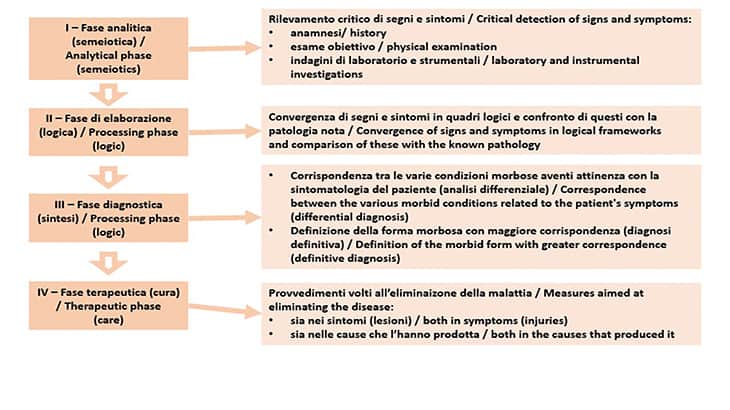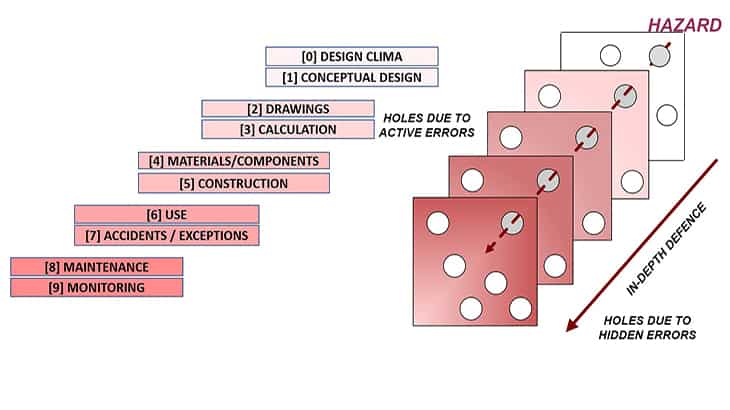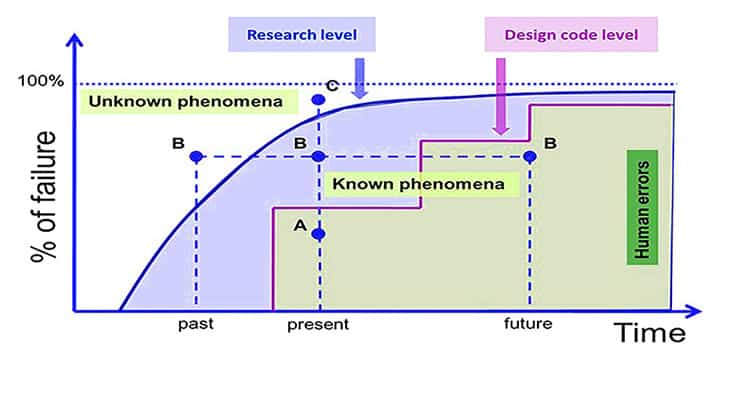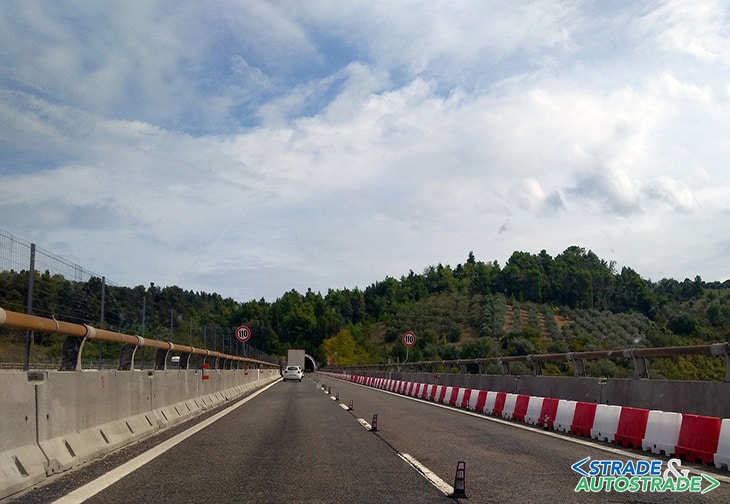The control and the assessment of the safety of existing bridges – part 2 ![]() Per la versione in Italiano: https://www.stradeeautostrade.it/ponti-e-viadotti/il-controllo-e-la-valutazione-della-sicurezza-dei-ponti-esistenti-seconda-parte/
Per la versione in Italiano: https://www.stradeeautostrade.it/ponti-e-viadotti/il-controllo-e-la-valutazione-della-sicurezza-dei-ponti-esistenti-seconda-parte/
Part 1 of the article on the control and the assessment of the safwty of existing bridges, published on “S&A” n° 142 July/August 2020, is online on https://www.stradeeautostrade.it/en/infrastructures-road-network/the-control-and-the-assessment-of-the-safety-of-existing-bridges-part-1/
Analogy with medicine
A useful analogy for setting up the evaluation of existing works is obtained from medicine, considering the clinical path of Figure 1.
It starts in the analytical phase (I) from the bridge documentation, inspections and investigations on site and in the laboratory. At this stage, the data and information can be paradoxically too many: tools such as algorithms based on artificial intelligence, the management of big data or representation means such as BIM can be helpful, but they are not resolving.
In fact, only in the phase (II) of logical processing and even more in the phase (III) synthesis of diagnostics, it is possible to fully define the state of the bridge: here an understanding of the structural behavior is essential for weigh those that are indicated generically as anomalies.
The evaluation of a work of art is, in fact, a holistic process that takes into account how this can enter into crisis as illustrated in the Reason model of Figure 2.
It can be considered that when weaknesses and shortcomings present to a greater extent or minor in all the illustrated steps are aligned, then there is the possibility of a structural crisis.

Particular attention must be paid to reconstructing the design climate, that is the set of knowledge at the time of the bridge design: in this sense, the lessons of the past studied with forensic engineering methods are irreplaceable. Furthermore, systemic aspects such as:
- the reverberation of the state of degradation of a single structural part (constraint, single element, etc.) on the possible functioning and change of the overall static scheme of the work;
- the influence on the change of collapse mode (for example, from flexural breakage mechanism or by cutting, or from ductile to fragile, …);
- the identification of the contingency scenario that can realistically come true soon for the structure in question;
- the influence on the compatibility of materials, in compliance with the precautionary principle;
- structural robustness are complex points that only reasoning based on a solid scientific and technical culture, in addition to a deep experience and a clear practical sense, can address [1 and 2].
Moreover, even the inspection examination on a structure can only consider Henri Bergson’s observation that the eye sees only what the mind is prepared to understand [3].

Formal security and substantial security
For a conscious assessment of the safety of a structure, it is worth realizing on what are the implicit assumptions underlying the construction standards, such as for Eurocode 0:
- the choice of the structural system and the design of the structure is carried out by suitably qualified and experienced personnel;
- execution is performed by personnel with the appropriate skills and experience;
- adequate supervision and quality control are provided during the execution of the works, i.e. in the design offices, factories, plants and on site;
- building materials and products are used as specified in EN 1990 or EN 1991 to EN 1999 or in the relevant execution standards, or reference material or product specifications;
- the structure will be adequately maintained;
- the structure will be used in accordance with the design hypotheses.
Furthermore, with reference to the measure of the probability of collapse expressed by the reliability index β, the actual failure frequency depends significantly on human error, which is not considered in the definition of the partial safety coefficients: β therefore does not provide an indication of the actual frequency of structural failure.
The formulation of security with these assumptions is to be understood as formal, being instead necessary for the substantial security of a work to consider precisely the aspects omitted above. Human error is largely responsible for structural crises, as highlighted in Figure 3.

We must also understand what Pugsley had already indicated in 1973 as the main causes of structural collapse:
- lack of experience of the teams responsible for design and construction;
- financial climate;
- industrial climate;
- political climate.
Frequently, by confusing substantial security with formal, new regulatory stratifications are introduced: this quantitative increase in the regulatory corpus, on the other hand, is not only inefficient but also pejorative due to its non-ergonomics.
About the danger of the proliferation of regulations, Pozzati said almost forty years ago: “But an excessive number of rules entails various of the drawbacks mentioned above and in particular: the impoverishment of autonomy and creativity, as the designer’s work is ensnared by the rules; the difficulty of discerning what really matters; the feeling of having, under the rules, very alleviated responsibilities; the not uncommon difficulty of realizing the reasoning that justifies certain rules, risking to consider these as algorithms, that is, of operating schemes that, once learned, thought is no longer called to justify”.
Conclusions
Circular 07/19/1967 n. 6736 / 61A1 over half a century ago presented, in an agile text of a few pages with a performance-based perspective, all the concepts necessary for the evaluation of works of art, proposing to organize the necessary periodic check in the most efficient way – intended in the most complete – of the static conditions of the works themselves.

It indicated, in fact, how the permanent surveillance on the state of consistency and on the static of works of art and road works would prevent damage or instability through the timely adoption of appropriate measures, allowing to discover in time warning signs of possible failures, injuries, incipient collapses, allowing through prompt interventions, limiting and precautionary measures, to avoid dramatic events and real catastrophes.
After the collapse of the Ariccia bridge near Rome, everything had already been written.
Bibliography
[1]. F. Bontempi – “I concetti elementari alla base della robustezza strutturale di ponti e viadotti – prima parte”, “Strade & Autostrade” n. 138 November/December 2019 and https://www.stradeeautostrade.it/ponti-e-viadotti/i-concetti-elementari-alla-base-della-robustezza-strutturale-di-ponti-e-viadotti-prima-parte/.
[2]. F. Bontempi – “I concetti elementari alla base della robustezza strutturale di ponti e viadotti – seconda parte”, “Strade & Autostrade” n. 139 January/February 2020 and https://www.stradeeautostrade.it/ponti-e-viadotti/i-concetti-elementari-alla-base-della-robustezza-strutturale-di-ponti-e-viadotti-seconda-parte/.
[3]. F. Bontempi, C. Crosti – “Tutta colpa di un fazzoletto?”, “Strade & Autostrade” n. 119 September/October 2016 and https://www.stradeeautostrade.it/ponti-e-viadotti/tutta-colpa-di-un-fazzoletto/.
Part 1 of the article is online on https://www.stradeeautostrade.it/en/infrastructures-road-network/the-control-and-the-assessment-of-the-safety-of-existing-bridges-part-1/
The control and the assessment of the safety of existing bridges – part 2 ![]() Per la versione in Italiano: https://www.stradeeautostrade.it/ponti-e-viadotti/il-controllo-e-la-valutazione-della-sicurezza-dei-ponti-esistenti-seconda-parte/
Per la versione in Italiano: https://www.stradeeautostrade.it/ponti-e-viadotti/il-controllo-e-la-valutazione-della-sicurezza-dei-ponti-esistenti-seconda-parte/

